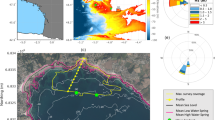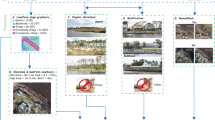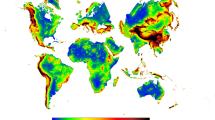Abstract
THERE have been several attempts in recent months to illustrate and define the degree of tilting or deformation of the various raised shorelines in Scotland1. Considerable use has been made of shoreline distance diagrams or graphs, whereby heights of the raised beaches in a particular area are projected on to a baseline, usually drawn in the supposed direction of maximum tilt of the series of shorelines as a whole. Each separate raised beach height is shown as a point on the diagram, the position of which is defined by altitude (usually given above O.D.) and projected distance along the baseline: the shorelines are depicted by lines or zones on the diagram, which in some cases are calculated best-fit regression lines to the series of points representing a given shoreline; in other cases they have been fitted by eye.
This is a preview of subscription content, access via your institution
Access options
Subscribe to this journal
Receive 51 print issues and online access
$199.00 per year
only $3.90 per issue
Buy this article
- Purchase on Springer Link
- Instant access to full article PDF
Prices may be subject to local taxes which are calculated during checkout
Similar content being viewed by others
References
Trans. Inst. Br. Geogr., 39 (1965).
McCann, S. B., Trans. Inst. Br. Geogr., 39, 87 (1966).
Chorley, R. J., and Haggett, P., Trans. Inst. Br. Geogr., 37, 47 (1965).
Whitten, E. H. T., US Office Naval Res., Geogr. Branch, Tech. Rep. No. 2.
Author information
Authors and Affiliations
Rights and permissions
About this article
Cite this article
MCCANN, S., CHORLEY, R. Trend Surface Mapping of Raised Shorelines. Nature 215, 611–612 (1967). https://doi.org/10.1038/215611a0
Received:
Issue Date:
DOI: https://doi.org/10.1038/215611a0
This article is cited by
-
Trend Surface Mapping of Cirque Floor Levels
Nature (1969)
Comments
By submitting a comment you agree to abide by our Terms and Community Guidelines. If you find something abusive or that does not comply with our terms or guidelines please flag it as inappropriate.



